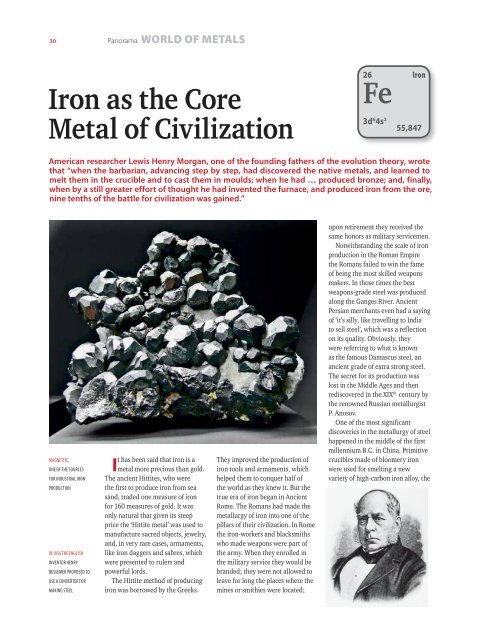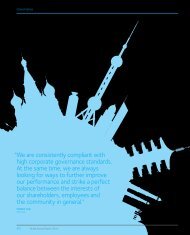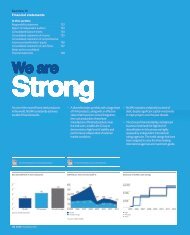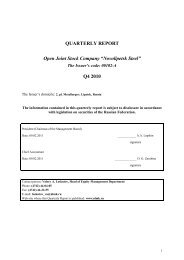NLMK Group
NLMK Group
NLMK Group
Create successful ePaper yourself
Turn your PDF publications into a flip-book with our unique Google optimized e-Paper software.
30<br />
Panorama WORLD OF METALS<br />
Iron as the Core<br />
Metal of Civilization<br />
26 Iron<br />
Fe<br />
3d 6 4s 2<br />
55,847<br />
American researcher Lewis Henry Morgan, one of the founding fathers of the evolution theory, wrote<br />
that “when the barbarian, advancing step by step, had discovered the native metals, and learned to<br />
melt them in the crucible and to cast them in moulds; when he had … produced bronze; and, finally,<br />
when by a still greater effort of thought he had invented the furnace, and produced iron from the ore,<br />
nine tenths of the battle for civilization was gained.”<br />
Magnetite,<br />
one of the sources<br />
for industrial iron<br />
production<br />
In 1856 the English<br />
inventor Henry<br />
Bessemer proposed to<br />
use a converter for<br />
making steel<br />
It has been said that iron is a<br />
metal more precious than gold.<br />
The ancient Hittites, who were<br />
the first to produce iron from sea<br />
sand, traded one measure of iron<br />
for 160 measures of gold. It was<br />
only natural that given its steep<br />
price the ‘Hittite metal’ was used to<br />
manufacture sacred objects, jewelry,<br />
and, in very rare cases, armaments,<br />
like iron daggers and sabres, which<br />
were presented to rulers and<br />
powerful lords.<br />
The Hittite method of producing<br />
iron was borrowed by the Greeks.<br />
They improved the production of<br />
iron tools and armaments, which<br />
helped them to conquer half of<br />
the world as they knew it. But the<br />
true era of iron began in Ancient<br />
Rome. The Romans had made the<br />
metallurgy of iron into one of the<br />
pillars of their civilization. In Rome<br />
the iron-workers and blacksmiths<br />
who made weapons were part of<br />
the army. When they enrolled in<br />
the military service they would be<br />
branded; they were not allowed to<br />
leave for long the places where the<br />
mines or smithies were located;<br />
upon retirement they received the<br />
same honors as military servicemen.<br />
Notwithstanding the scale of iron<br />
production in the Roman Empire<br />
the Romans failed to win the fame<br />
of being the most skilled weapons<br />
makers. In those times the best<br />
weapons-grade steel was produced<br />
along the Ganges River. Ancient<br />
Persian merchants even had a saying<br />
of ‘it’s silly, like travelling to India<br />
to sell steel’, which was a reflection<br />
on its quality. Obviously, they<br />
were referring to what is known<br />
as the famous Damascus steel, an<br />
ancient grade of extra strong steel.<br />
The secret for its production was<br />
lost in the Middle Ages and then<br />
rediscovered in the XIX th century by<br />
the renowned Russian metallurgist<br />
P. Anosov.<br />
One of the most significant<br />
discoveries in the metallurgy of steel<br />
happened in the middle of the first<br />
millennium B.C. in China. Primitive<br />
crucibles made of bloomery iron<br />
were used for smelting a new<br />
variety of high-carbon iron alloy, the

















